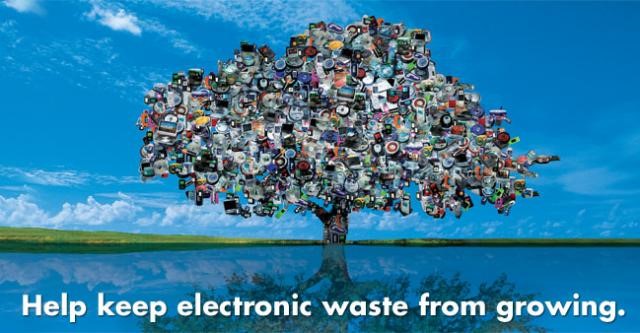Era Of E-waste Disaster
As electronic products (computers, televisions, laptops, mobile phones, washing machines, TV etc.) end their useful life they are called as electronic waste (e-waste). Due to the relatively new issue of e-waste disposal, many countries – especially developing ones like India – do not yet have efficient system to dispose of the same. As a resultant a black market has emerged, with illegal traffickers posing as legitimate disposal services and then dumping tons of e-waste in random spots. This has led to environmental risks from the internal components of discarded electronics, specifically heavy metals. Here are some of the main ways that different types of e-waste can negatively affect environment:


Air Pollution
Many rudimentary e-waste “processing plants” are not ethically run – or safe. For example, some e-waste traffickers burn open computer wires in order to get to the copper inside – a valuable commodity. The open burning can release hydrocarbons into the air, while the chemical stripping of gold-plated computer chips leads to emissions of brominated dioxins and heavy metals.
Water Pollution
Cathode ray tubes, often found in older televisions, video cameras and computer monitors are often broken apart, the yoke removed and the shell dumped. Contents in the shell, such as lead and barium, could leach through the soil and into the ground water of local communities. This endangers not just the people who drink and bathe with this water but also the different species of wildlife that rely on the water to sustain.


Soil Pollution
Another study of such landfill found wind patterns disperse toxic particles across the region near to it. Such areas are at-risk due to the toxins entering the “soil-crop-food pathway,” which is one of the most common ways that heavy metals enter the human body.
Information Security
In addition to being a risk to the environment, e-waste also poses a potential security threat to both individuals and businesses. If a hard drive is not properly erased before it’s thrown away, it can be opened, potentially putting sensitive information in the hands of the wrong people. Credit card numbers, financial data and bank account information can all be obtained by those trained to do so.
There is a surplus of e-waste due to the technological advancement (which renders electronics as obsolete in a short period of time) and the urge of the so-called ‘modern-day’ consumers to buy new products more often than required. All these have led to the million units of electronic scrap being discarded every year and sadly the number will only have an increasing trend in the coming years (UNEP has estimated a 500% rise in old computers). An estimated 50 million tons of E-waste are produced each year. The USA discards 30 million computers each year and 100 million phones are disposed of in Europe each year. The Environmental Protection Agency estimates that only 15–20% of e-waste is recycled, the rest of these electronics go directly into landfills and incinerators
India generated e-waste of approximately 1.47 lakh tonnes (2005) and 1.7 million tonnes (2014); becoming the fifth biggest e-waste generator in the world (The Hindu, 2014). Mumbai (96000 tonnes/annum), Delhi (67000 tonnes/annum), and Bengaluru (57000 tonnes/annum) are leading cities for generating the highest e-waste in the country. The number could touch 3.6 lakh tonnes for the country by 2020.
Apparently, only 5-10% of the e-waste generated in India is handled by the organized sector. The informal sector is handled by the Kabadiwallas who have a better ‘door –step’ presence and relationship with their clients and thus run a better business (as far as money is concerned). But this is solely due to the reason that the e-waste is not properly handled and regulated in India. These Kabadiwallas employ children as laborers who dismantle/ burn the e-waste to collect the gold, silver and other precious metals to be sold in the market. These people are exposed to harmful toxins and poor work conditions.
Some components of e-waste are hazardous (due to the presence of cadmium, beryllium, lead and mercury); for example CRTs (cathode ray tubes) found in TVs and monitors. Just disposal of e-waste in landfills (a common practice in India) may cause severe environmental hazards (leachate may pollute water bodies while plastics of the e-waste may produce dioxins on burning).
What can be done further??
- Rules on e-waste handling and management must be stringent.
- Setting up transfer stations in municipalities or having waste segregation for further reuse and recycle.
- Public awareness to understand the importance of recycling and extending the life of e-waste and at the same time upcycle by obtaining precious components from the e-waste.
- Could be a major drive of the Swachh Bharat Abiyaan.

| M | T | W | T | F | S | S |
|---|---|---|---|---|---|---|
| 1 | 2 | 3 | 4 | 5 | 6 | |
| 7 | 8 | 9 | 10 | 11 | 12 | 13 |
| 14 | 15 | 16 | 17 | 18 | 19 | 20 |
| 21 | 22 | 23 | 24 | 25 | 26 | 27 |
| 28 | 29 | 30 | ||||
ALL CONTACTS
- A-148, 2nd Floor, Gujranwala Town, Delhi - 110009
- +91 98188 91223
- donations@kib.org.in
SUBSCRIBE
Never miss out on any news and updates by Keep India Beautiful.
- Keep India Beautiful. Copyright 2024











